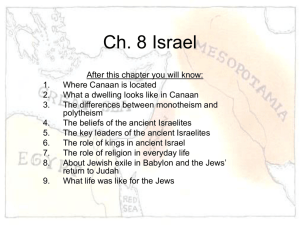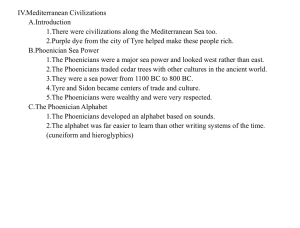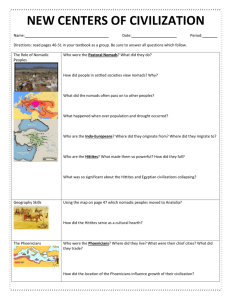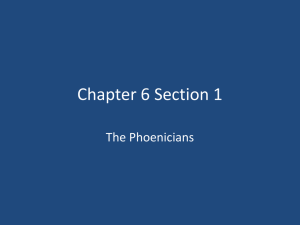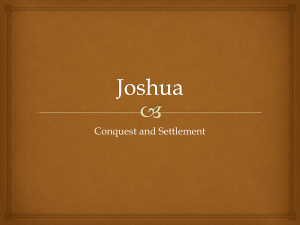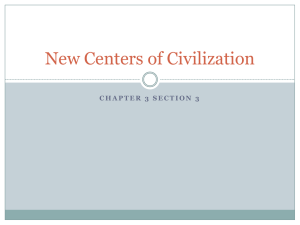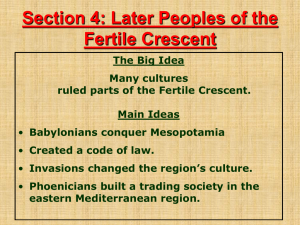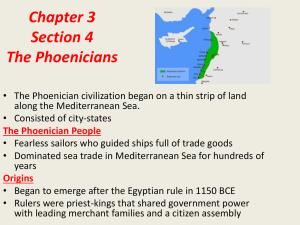ANCIENT Chapter 2 Section 4 ppt
advertisement
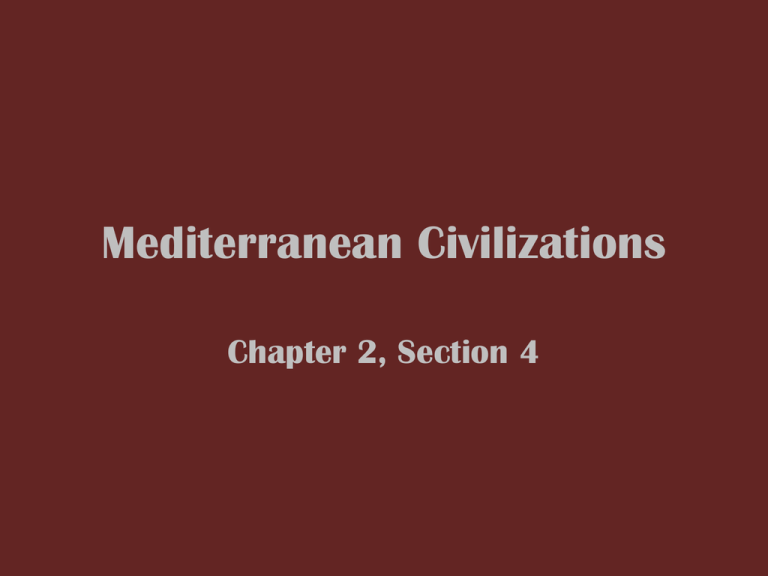
Mediterranean Civilizations Chapter 2, Section 4 City of Tyre • While the great empire of Hammurabi was rising and falling, the people of a poor city on the shores of the Mediterranean Sea were getting rich by gathering snails. • Snails that washed up the shore produced rich purple dye. • Highly valued by wealthy people throughout the Mediterranean region • Ships from Tyre sold the dye at extremely high prices became a wealthy and active city City of Tyre The Phoenicians: Sailors of the Mediterranean • Tyre major city in region called Phoenicia • Outlook was toward the west, the Mediterranean Sea and surrounding growing cities • Had settled in a land with dense forests of cedar trees – Sold the wood along with snails to neighbors The Phoenicians: Sailors of the Mediterranean • As trade grew, the Phoenicians looked to the sea to increase their profits – Became world’s largest trading empire – 1100 B.C. – 800 B.C. = great sea power • Ships sailed all over the Mediterranean Sea • Sailed out into the story Atlantic – Sailors came back and shared stories of sea monsters to keep competitors away from Atlantic Trade The Phoenicians: Sailors of the Mediterranean • Trade brought rich goods from lands around the Mediterranean Sea to the Phoenician cities of Tyre and Sidon. • Bazaars swelled with foods brought from faraway places – Figs, olives, honey, spices – Merchants sold strange animals giraffes and warthogs from Africa; bears from Europe Bazaar The Phoenician Alphabet: One Sound, One Letter • Needed simple writing because they had so much trade • Cuneiform = too complicated • Found a way to write using 22 symbols • Phoenician alphabet set of symbols that represented the sounds of the language • Forms the basic alphabet that people in the USA and other countries use today • Each of the 22 letters stood for one consonant sound. The Phoenician Alphabet: One Sound, One Letter • Easier to learn than cuneiform • Many more people could learn to write besides scribes Phoenician Alphabet The Rise of the Israelites • Hebrews (later known as Israelites) small band of people settled along the shores of the Mediterranean • Made a deep impact on our civilization even though they never built a large empire • Traced beginnings to Mesopotamia • For hundreds of years, lived as shepherds and merchants who grazed their flocks outside Sumerian cities The Rise of the Israelites • According to the Bible, Abraham led his people to a belief in one God monotheism • God promised Abraham that his people would have their own land if they would follow his word • 1900 B.C. Abraham led the Israelites from Mesopotamia to a new home in Canaan – 1800 B.C. famine spread across Canaan • Time when there is so little food that many people starve • Caused the Israelites to flee south to Egypt The Rise of the Israelites • Lived well in Egypt for about 600 years • Enslaved when an Egyptian king grew jealous of their wealth and suspicious of their power Return to Canaan • Moses, an Israelite hero, led the enslaved people out of Egypt • Wandered the desert of Sinai for the next 40 years – God have the Israelites the Ten Commandments • Returned to Canaan and eventually began to build their own cities Map of Canaan and Egypt Conquest of Canaan • Israelites faced opposition as they moved further north into Canaan • Conquered Canaan after several fierce wars • Two kings led them to victory – Saul first king of the Israelites – David next king who united the 12 tribes into a single nation; established his capital at the city of Jerusalem Conquest of Canaan • Solomon, David’s son, inherited the kingdom – Grew prosperous through trade – Developed a sea trade with neighboring lands • First voyage = brought back more than 13 tons of gold Conquest of Canaan • Solomon transformed Jerusalem into a magnificent capital. • Most prized monument = temple in the center of the city became the central place of worship for the Israelites Jerusalem Temple Jerusalem Temple Jerusalem Temple Conquest of Canaan • Solomon’s building projects were very expensive. • Country faced hard times and after his death, divided into 2 kingdoms – Northern = Israel – Southern = Judah • Assyria, the dangerous neighbor, was gaining power in the divided kingdom. Conquest of Canaan • 722 B.C. Assyrians seized the kingdom of Israel – Punished the Israelites by exiling thousands to distant parts of the empire • Exile force a people to live in another country • About 135 years later, Judah fell to the Chaldeans and they were exiled as well.
